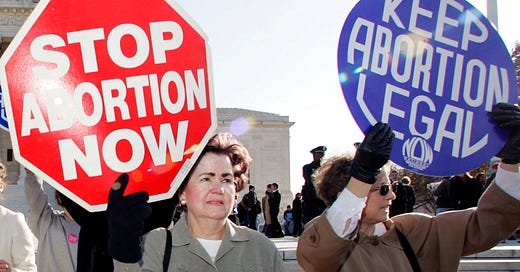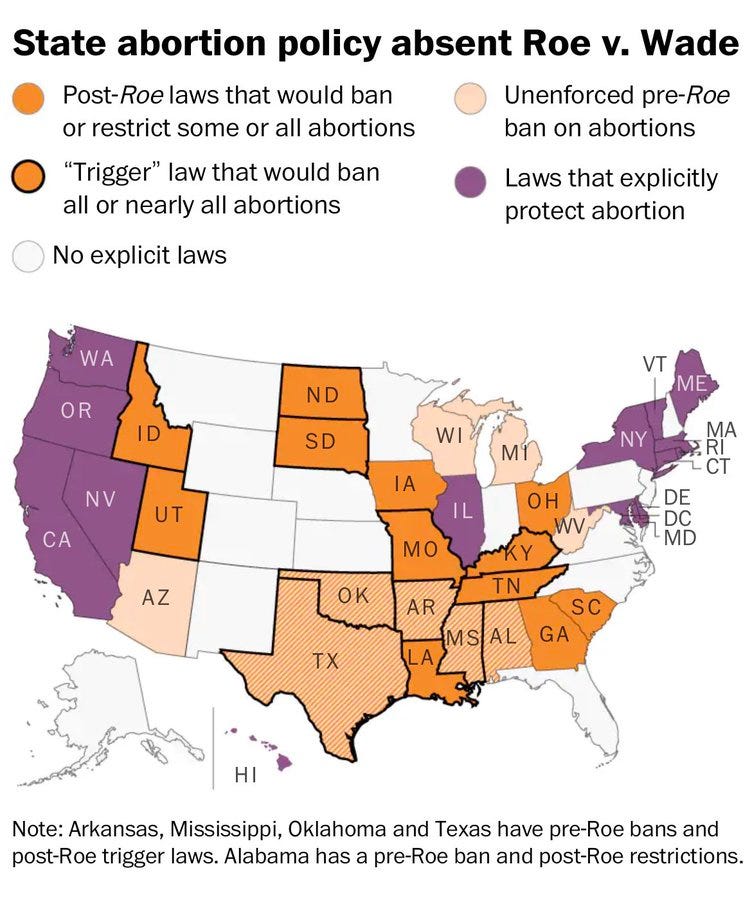Initial thoughts on the Supreme Court's leaked Roe v. Wade draft decision
No one really knows how this will play out
Late last night, Politico published a story that sent a jolt across the country: according to a leaked draft of a majority Supreme Court opinion written by conservative Justice Samuel Alito, America’s top court appears ready to overturn Roe v. Wade and Planned Parenthood v. Casey, two previous Court decisions that for decades codified the right to an abortion into law. To be clear, what was leaked is not a final ruling, and the Supreme Court today claimed that this ostensibly does not represent any justice’s final position. Additionally, there are reports that Chief Justice John Roberts, a conservative, is not completely on board with it and may even be attempting to sway one of the other conservative justices to let Roe stand for now.
Still, such a decision would not be entirely surprising. While I had thought the Court might slowly chip away at Roe, rather than taking it out all at once, the move toward this type of ruling has been decades in the making. Anti-abortion activists have worked relentlessly since Roe was first decided in 1973 to build a majority on the Court that would eventually overturn the previous decision.
So, it is worth grappling with the implications of this news if the draft opinion does indeed offer a preview of how the Court may rule this summer. Here are a few things I think are worth highlighting.
The immediate implications
Should Roe be overturned, abortion would immediately be outlawed in 13 states. By contrast, 16 states and the District of Columbia have laws on the books that explicitly protect the right to an abortion.
As a Washington Post analysis of changes to abortion policies across the country shows, many states have moved in one direction or the other over the past two decades, and these trends are likely to accelerate in a post-Roe world.
To be sure, even if the right to an abortion is not codified into law for all Americans, some people will still be able to get them. However, it will likely be much more inconvenient, and there are sure to be disparities in access depending on one’s socioeconomic status.
Americans’ views on abortion and Roe
Abortion has long been one of the major fault lines in American politics and culture, and the country is fairly evenly divided between those who consider themselves “pro-life” and those who identify as “pro-choice.”
However, the public is generally opposed to outright bans on abortion. According to Gallup, just 19% of the public supports making abortion illegal in all circumstances, something that, as previously mentioned, would happen in at least 13 states if Roe were overturned. Another 32% support keeping the procedure legal in all circumstances, and a near-majority (48%) believe it should be legal but only under certain circumstances.1
This trend holds true at the state level as well. According to Pew Research, majorities (or pluralities) in 33 states believe abortion should be legal in all or most cases.
On the issue of Roe v. Wade, the public is even clearer about where it stands: they oppose overturning it by a wide margin.





All of these positions were reaffirmed in a new ABC-Washington Post poll that was released today:
The public is also very sympathetic to most reasons why a woman might pursue an abortion:
Of note, while fully 79% of the country supports allowing women who were raped or the victims of incest to get an abortion, many of the newest laws banning the procedure do not allow for those exceptions.
How the leak could impact the Supreme Court
After the news of the leaked memo, one reaction in some corners was to bemoan the fact that it was leaked at all. Indeed, such a leak is unprecedented in the Court’s history. As Politico noted, “No draft decision in the modern history of the court has been disclosed publicly while a case was still pending.” It remains to be seen how this could impact trust levels among the justices and their clerks.
That said, to suggest that this leak will threaten the stability of the Court, while possibly an accurate assessment, misses the larger context of the institution’s longer-term legitimacy crisis. Even if what was previewed in the memo is accurate, this would be far from the first time that the Court has taken divisive and seemingly political actions or exhibited controversial behavior that called into question its legitimacy in the eyes of the public. Though the Court was generally viewed favorably among a large majority of Americans in the 2000s (minus a brief spell around the time George W. Bush nominated Harriet Miers), its approval rating has declined from 61% in 2010 to 40% this year—the lowest point since at least the turn of the century.
However, as others have pointed out, although the Court may have precipitated some of this loss of trust itself, this decline would simply bring it up to speed with the rest of America’s struggling institutions.
At any rate, regardless of who leaked it, it now seems far less likely that any behind-the-scenes jockeying Roberts might have been doing to save Roe will be effective. Justices who were cited as supporting the draft opinion would be seen as caving to political influences if they changed their vote now. There’s a good bet that what Alito authored is the decision that will be formally handed down in the next couple of months.
Moreover, it is important to keep some perspective here: the leak is not the most important part of this story. While there are legitimate questions about how that will impact the Court, the bigger issue is what this ruling will do to American society. On that point, no one can be sure.
The possible political ramifications
Relatedly, no one can say with any certainty what the political fallout from this decision might be. As outlined in the polling above, the public is overwhelmingly against overturning Roe. However, what does that mean in practice? Here are a handful of questions that will be worth watching in the months and years ahead:
How many people will become single-issue voters on abortion who were not already—or at least consider it a primary voting issue for themselves? And what side of the issue do they come down on?
Will abortion overtake inflation as a top issue in this year’s midterm elections for any voters, thus potentially dealing Democrats a lifeline? Will there be a difference in the salience of this issue is in elections for Congress, where a Republican majority could pass a national abortion ban, and elections at the state level, where most of these debates are likely to play out?
Will working-class white women, who made up nearly one-quarter of the 2020 electorate and voted for Trump by 21 points, feel the impact of such a decision, and will it sway their vote choice at all moving forward?
As one writer pointed out, having Roe in place forced—or at least allowed—Republicans to pass policies that generally aligned with public opinion rather than the views of the most strident, anti-abortion activists. For many years, states imposed some restrictions on the procedure but never outright bans. Republicans could simply say the Court precedent blocked their ability to go any further. If said precedent is overturned, the most extreme position on that issue—support for a total ban—will be front and center, and activists who support that stance will expect their elected officials to follow through now that the law permits it. Do Republican politicians forge ahead with those policies, in defiance of the views, in many cases, of a majority of their state’s residents?
The US stands alone in moving to the right on abortion
Several deeply Catholic countries—including Ireland, Argentina, Mexico, and Colombia—have in recent years rescinded their bans on abortion, not because they suddenly approved of the procedure but because they came to view bans as an ineffective way of dealing with the issue.
While research shows that there is often a link between the expansion of women’s rights and a country’s support for democracy, there are growing fears that the opposite is true as well. The U.S., which is alarmingly now considered a backsliding democracy, joins the ranks of Poland and Nicaragua—two countries with their own troubling commitments to democracy—to compose the full list of countries that have tried to make abortion access more restrictive in recent years.
That 32% and 48% are the highest and lowest levels of support for those positions, respectively, since 1993, a possible sign that the public has warmed to abortion rights as the Supreme Court has built a majority large enough to overturn Roe.











